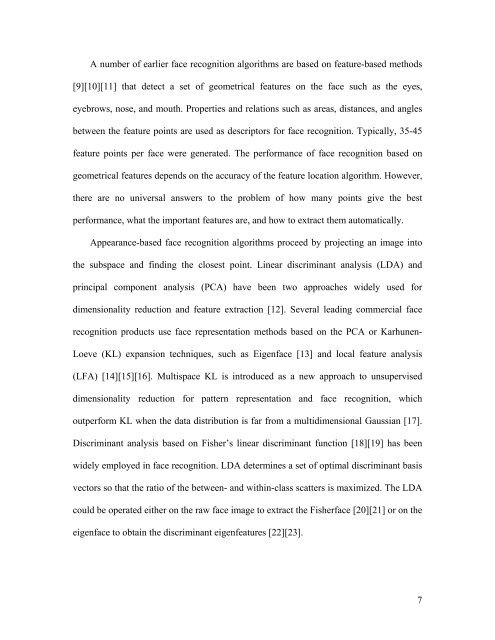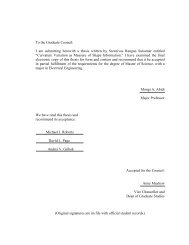Fusion of Visual and Thermal Face Recognition Techniques: A ...
Fusion of Visual and Thermal Face Recognition Techniques: A ...
Fusion of Visual and Thermal Face Recognition Techniques: A ...
Create successful ePaper yourself
Turn your PDF publications into a flip-book with our unique Google optimized e-Paper software.
A number <strong>of</strong> earlier face recognition algorithms are based on feature-based methods<br />
[9][10][11] that detect a set <strong>of</strong> geometrical features on the face such as the eyes,<br />
eyebrows, nose, <strong>and</strong> mouth. Properties <strong>and</strong> relations such as areas, distances, <strong>and</strong> angles<br />
between the feature points are used as descriptors for face recognition. Typically, 35-45<br />
feature points per face were generated. The performance <strong>of</strong> face recognition based on<br />
geometrical features depends on the accuracy <strong>of</strong> the feature location algorithm. However,<br />
there are no universal answers to the problem <strong>of</strong> how many points give the best<br />
performance, what the important features are, <strong>and</strong> how to extract them automatically.<br />
Appearance-based face recognition algorithms proceed by projecting an image into<br />
the subspace <strong>and</strong> finding the closest point. Linear discriminant analysis (LDA) <strong>and</strong><br />
principal component analysis (PCA) have been two approaches widely used for<br />
dimensionality reduction <strong>and</strong> feature extraction [12]. Several leading commercial face<br />
recognition products use face representation methods based on the PCA or Karhunen-<br />
Loeve (KL) expansion techniques, such as Eigenface [13] <strong>and</strong> local feature analysis<br />
(LFA) [14][15][16]. Multispace KL is introduced as a new approach to unsupervised<br />
dimensionality reduction for pattern representation <strong>and</strong> face recognition, which<br />
outperform KL when the data distribution is far from a multidimensional Gaussian [17].<br />
Discriminant analysis based on Fisher’s linear discriminant function [18][19] has been<br />
widely employed in face recognition. LDA determines a set <strong>of</strong> optimal discriminant basis<br />
vectors so that the ratio <strong>of</strong> the between- <strong>and</strong> within-class scatters is maximized. The LDA<br />
could be operated either on the raw face image to extract the Fisherface [20][21] or on the<br />
eigenface to obtain the discriminant eigenfeatures [22][23].<br />
7
















